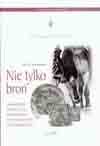(Nie)militarne naczynia. Fakty i mity
(Non)military vessels. Facts and myths
Author(s): Andrzej Janowski, Tomasz KurasińskiSubject(s): Archaeology
Published by: Łódzkie Towarzystwo Naukowe
Summary/Abstract: The authors discuss the issue of presence of vessels in the inventory of an early-medieval warrior. The goal was to answer a question of to what extent this category of artifacts belonged really to non-military accessories. The source basis was constituted by 106 burial sets, equipped with military artifacts and containing vessels, recorded at burial grounds from Polish lands, utilized in the period of 10th – 13th centuries. Basing on the find overview, three basic groups of vessels were distinguished: wooden vessels (a bucket, a scoop, and others), clay and metal ones (bronze bowls). The discussion included also leather vessels, only hypothetically present in the graves. The authors express an opinion, that all of the mentioned vessel categories could have been used by early- Medieval warriors. Material, shape and technical parameters of the buckets makes them especially suitable for this role, although basing on the data present we cannot unambiguously identify these finds as related to riders. They could have been used by any military formation. The smallest specimens were used as drinking mugs, larger ones were used mainly for storing of food or as containers of liquids, subsequently poured to smaller vessels. The largest ones, although not numerous, could have been used for horse watering. A small number of other types of wooden objects in the graves with military artifacts does not allow any further discussion. Ceramic vessels were probably used ad hoc as mugs during military expeditions. Miniature specimens were included in personal inventory, while larger specimens probably followed the army transported on wagons. Bronze bowls were included in grave sets containing horse equipment, caparison elements and prestigious weapon elements. All this suggests, that they were used (as vessels for washing hands) by the representatives of the contemporary social elites, serving most probably as riders. Considering the luxurious character of the bowls, however, we have doubts about practical usage of this category during military expeditions. No sources exist that would prove the use of leather vessels by the warriors. The performed analysis excludes the possibility that the vessels found in graves could have been used for liquid transportation, since all of them, independently on their type, were open in form. They could, however, been used on camps, as vessels for consumption of meals and fluids. Probably most of the analyzed vessels were the warrior’s property.
Journal: Acta Archaeologica Lodziensia
- Issue Year: 2008
- Issue No: 54
- Page Range: 61-88
- Page Count: 28
- Language: Polish

